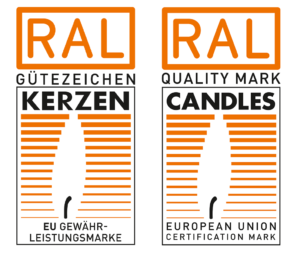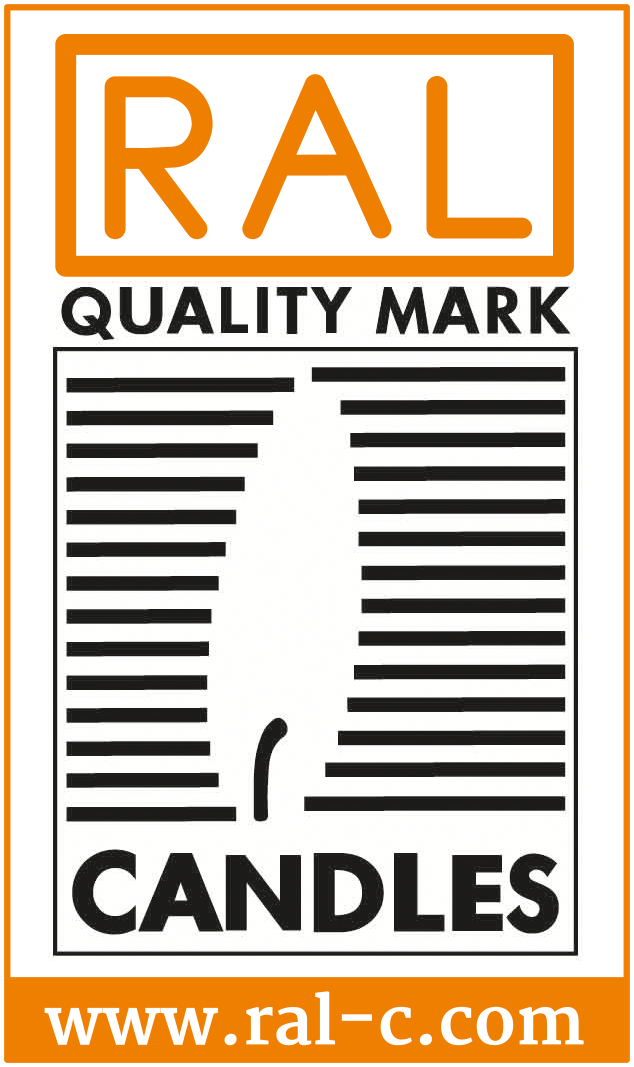Everything you need to know about candles from A to Z
A
- Altar candles: Altar candles have been used for a long time and not only for liturgical purposes; they also enrich any lifestyle setting (chimney candles), or e.g. as decorative garden lights.
- Azo dyes: Azo dyes, which generate particularly light-fast, stable and strong colours, are the largest group of dyes with a correspondingly large scope of application. Azo dyes themselves are generally not hazardous to health. However, some can be metabolised into their basic materials, the so-called “aromatic amines”, in the human body. Some of these amines are harmful to health.
B
- Beeswax: Beeswax is a metabolite of the honeybee. It is produced in the wax glands of the honeybee and used for the construction of honeycomb. Beeswax is used to produce environmentally friendly, safe and pleasantly scented candles or honeycomb candles, which are loved by enthusiasts. Beeswax is a scarce raw material and therefore more expensive than other candle waxes.
- Burning on one side: If a candle burns to one side, carefully bend the wick in the other direction to compensate for the difference in burning or check that the candle is level. Never bend a stiffened wick and certainly don’t break it off, as this makes it difficult to relight.
- Burning time: Candles should always be allowed to burn until the full burn pool becomes liquefied. Otherwise a hollow centre is produced, soot occurs or the flame withers. A normal candle burns between 7 and 10 grams of wax per hour.
C
- Candle edge: Do not damage the edge of the candle, as this will cause the liquid wax to leak. If the edge of the candle is too high, it can be carefully cut off with a knife while warm.
- Candleholder: Candles must be fixed (on candlesticks or in bowls) so that they cannot fall over whilst burning. The fixture must be heat-resistant and non-flammable. If the candle does not fit properly, simply allow a few drops of wax to drip into the holder and place the candle on it immediately: it will become “fixed” as the wax cools.
- Christmas time: Christmas without candles would be like Easter without eggs! When it comes to Christmas tree candles in particular, look out for the RAL Quality Mark, as candles with this mark burn with little smoke and soot.
- Church services: Candles are a regular sight on altars in all church services, seen again and again throughout the Christian calendar: the four candles on the Advent wreath, Candlemas candles, Easter candles or candles for First Communion. Lighted candles in front of images of Mary or sacred images are a sign of prayer and worship.
- Citronella candles: Citronella candles not only smell pleasantly fresh, they also keep annoying midges and mosquitoes away and are therefore the ideal companion for mosquito-free summer evenings.
- Colours: Coloured candles are made by colouring wax, with a colour selection based on the respective seasonal trends.
D
- Distance Apart: When placing several candles next to each other, make sure that there is sufficient space (at least 10 cm) between the individual candles. If the distance is too small, too much heat will develop: the candles will deform and burn faster or unevenly and start dripping.
- Draughts: Draughts should be avoided, as candles will otherwise burn too quickly, drip or give off sooty smoke.
- Drawing method: Candle drawing is one of the oldest methods for manufacturing candles. In the past, candles were only made by hand; today, however, candles are produced with machines in most cases. A machine is used to pull a long wick (several hundred meters) through a wax bath until the desired thickness is reached.
E
- Easter candles: These are egg-shaped candles (available in various sizes up to the size of an ostrich egg) and in all conceivable colour tones. They are especially ideal for a cheerful, springlike Easter table.
- Evening primrose: Belong to the genus of the evening primrose (onagraceae), whose flowers only open at night and have nothing in common with wax candles.
- Extinguishing the flame: If the wick is dipped into the liquid wax to extinguish it, and then straightened again, it will not smoke and the candle will be easier to light next time. And it won’t break off so easily.
F
- First candle: The oldest wax candle still preserved today comes from the 1st century AD and can be found in the town of Vaison-la-Romaine in Provence.
- Flame: A candle flame is an open flame and can get up to 1400°C. Though creating a romantic and cosy atmosphere, they should never be left unattended: never allow candles to burn unsupervised!
G
- Gütegemeinschaft Kerzen e.V.: The Association of German Candle Manufacturers, Verband deutscher Kerzenhersteller e.V., initiated the RAL Quality Mark for Candles – thereby also founding the Quality Association – with the aim of providing the consumer with a visible quality seal. Candles with the RAL Quality Mark make immediately apparent that they are quality tested. Otherwise you don’t know what you’re buying.
H
- Heat: A candle flame can reach around 1400°C. Do not expose candles to direct sunlight and keep them away from heat sources (e.g. radiators) as they will otherwise deform.
M
- Moulding process: In this production process, liquid wax is poured into moulds, a wick is pulled taut in the middle; it is particularly suitable for candles that are coloured right through.
O
- Origin: The origin of “candles” dates back around 3000 years: at that time, they consisted of straw, hemp, reed or other similar materials, which were soaked in resin or tallow. As a result, the odour was somewhat “animal-like”.
P
- Painted candles: For decorative purposes, the surface of candles may be coated with paint. All painted candles bearing the RAL Quality Mark demonstrably contain no polluting raw materials and are therefore completely harmless to health.
- Paraffin: Paraffin is the raw material for candles: It is waxy, odourless and non-toxic. It is insoluble in water, but slightly soluble in gasoline. Today, paraffin is mainly produced from fossil fuel oil. The main consumer is the candle industry.
- Personalised candles: For any occasion – whether wedding candles, anniversary candles or baptism candles – suitable candles are available from Quality Association for Candles members.
- Pillar candles: Pillar candles have a secure base and can be used in different ways, as they are available in many different sizes and colours.
- Pressing process: Candle production using the pressing process has increased considerably in recent decades and is a widely used method of production in the manufacture of consumer candles. A distinction is made between a stamp press and an extrusion press. Powder paraffin is required for both procedures.
Q
- Quality seal: The “RAL Quality Mark for Candles” guarantees tested quality. The RAL Quality Mark is awarded exclusively to products that both substantiate their environmental and health compatibility and demonstrate high, reliable practical value in neutral, controlled testing by the German Motor Vehicle Inspection Association (DEKRA). This makes the “RAL Quality Mark for Candles” the decisive criterion for those customers who favour good quality over the lowest price.
R
- RAL Quality Mark for Candles: This allows the consumer to recognise high-quality candles amongst the variety of products available. The RAL Quality Mark is awarded exclusively to products that both substantiate their environmental and health compatibility and demonstrate high, reliable practical value in neutral controlled, regular testing by the German Motor Vehicle Inspection Association (DEKRA).
- RAL: RAL is one of the world’s oldest labelling professionals. Consumers, businesses, industry and trade have relied on RAL for over 90 years.
- RAL Quality Mark: Candles with the RAL Quality Mark produce low levels of soot and smoke and contain only high-quality wicks. The candles also do not drip when used correctly; the shapes, colours and dimensions of the candles are consistent and reliable.
S
- Safety: Candles are open flames that should never burn unattended.
- Saint’s days: A personalised, individual candle makes a beautiful gift for a saint’s day.
- Self-extinguishing candles: Candles diffuse a wonderful light and create a pleasant atmosphere. But burning candles don’t just light up your eyes – an unattended candle may well become a “burning” problem.Self-extinguishing pillar candles with the RAL Quality Mark are therefore ideal for (Christmas) decorations: This is because a special patent prevents hot wax from leaking and igniting. In addition, the flame self-extinguishes, significantly reducing the risk of fire.
- Scented candles: Scented candles offer a wonderful combination of candlelight and the corresponding fragrance note for the mood. Ethereal and nature-identical fragrances are used to manufacture the candle fragrances. The fragrance range of RAL candles with the RAL Quality Mark ranges from A to Z.
- Stearin: Stearin is a renewable raw material, which is plant or animal based. Stearin candles have very good temperature stability.
T
- Taper candles: Taper candles — also known as candlesticks — are very much at home on dining tables.
- Tealights: Tealights likely came about as a means of keeping tea and other beverages warm. Presumably the casing was there first, which was then filled with paraffin wax. The moulding technique only emerged in the 1960s. Today, tealights have a diameter of approximately 38 mm and are now also for decorative purposes in a wide variety of settings. As such, a non-combustible surface must always be used and tealights must not be arranged too closely to one another. It is important that the wick produces only a small flame so that it does not get out of control. Quality and safety are closely interconnected. It is important that the wick is of high quality so that it does not break off and instead burns safely and for a long time — tealights with the RAL Quality Mark guarantee that these criteria are met. A certified tealight burns for around four hours.
V
- Verband Deutscher Kerzenhersteller (Association of German Candle Manufacturers): With 40 member companies, the Association of German Candle Manufacturers encompasses more than 95% of German production.
W
- Wax pool: The wax pool should always be kept clean: Please remove scraps of matches, pieces of wick and other impurities as this prevents even burning.
- Wax stains: As a rule, wax stains can easily be removed or flaked off. If this is not possible, remove stains from textiles by placing absorbent paper (e.g. blotting paper) on the wax stains and applying a hot iron to the paper, enabling the wax to be absorbed via the paper. If wax is on smooth surfaces, you can use a hair dryer to turn the wax back into liquid and then wipe the liquid away with paper.
- Wick length: The ideal wick length is approx. 10–15 mm. A longer wick tends to give off sooty smoke. The wick (made from 100% cotton) should be shortened carefully with scissors, for example, special wick scissors. If the flame looks like it might go out, the wick is too short. In this case, extinguish the flame and carefully pour off some liquid wax. Then cut off the edge of the candle that is too high and then light it again. The wick thickness is matched to the manufacturing process as well as to the candle thickness.






